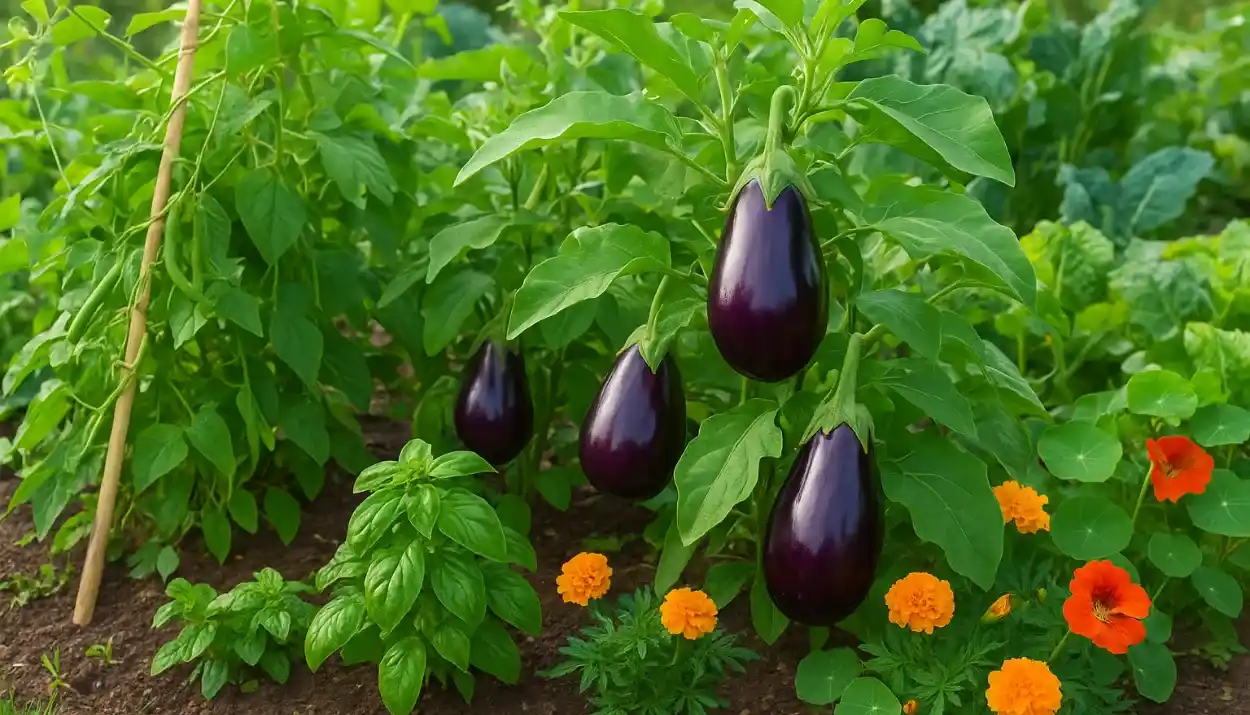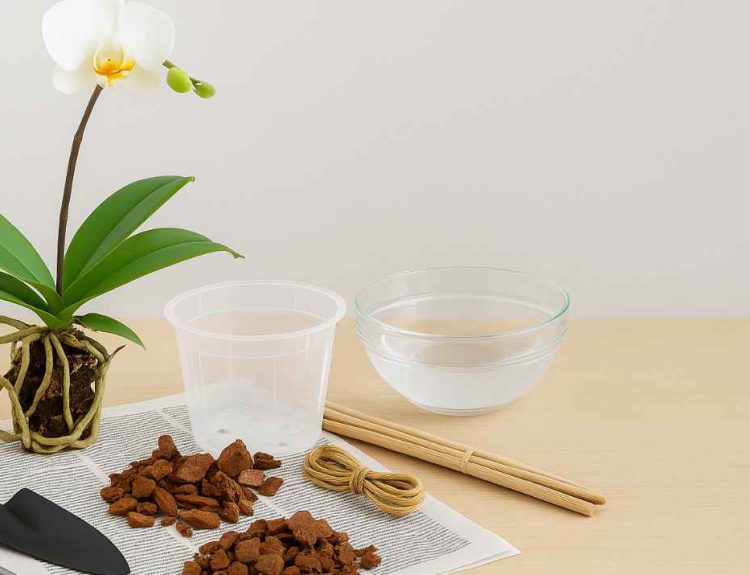If you’ve ever grown eggplants, you know they’re divas of the vegetable garden stunning to look at, delicious on the plate, but demanding when it comes to care. They sulk in poor soil, attract a laundry list of pests, and drink up nutrients as though the soil were a bottomless pantry. For gardeners, the trick isn’t just keeping eggplants alive; it’s helping them thrive.
That’s where companion planting comes in. Pairing eggplants with the right allies can mean fewer pests chewing through your leaves, richer soil that replenishes itself, and ultimately, higher yields without resorting to chemical quick fixes. Even better? Done well, companion planting boosts biodiversity in your garden, creating a more resilient little ecosystem that does the heavy lifting for you.
In this guide, we’ll break down the best and worst neighbors for your eggplants. From nitrogen-fixing beans to pest-repelling herbs (and the one plant you should never let near them), consider this your science-backed roadmap to smarter, healthier planting.
Quick Overview of the Best Companion Plants for Eggplant
- Beans and peas: fix nitrogen in the soil and boost fertility.
- Basil, oregano, thyme, and French tarragon: repel pests and attract pollinators.
- Marigolds, nasturtiums, and borage: deter insects, improve pollination, and increase yields.
- Spinach, broccoli, and kohlrabi: improve soil health, conserve moisture, and provide pest control.
Why Companion Planting Works for Eggplants
Eggplants are notorious heavy feeders. They need a steady supply of nitrogen and other nutrients to fuel their leafy growth and fruit production. Left on their own, they quickly exhaust the soil, leaving gardeners scrambling to supplement with fertilizers.
Companion planting effectively addresses this issue. Legumes like beans and peas literally pull nitrogen from the air and convert it into a form that eggplants can use a natural fertilizer factory running beneath the soil. Aromatic herbs like basil and oregano add another layer of defense, masking the scent of eggplant leaves and confusing pests like aphids and spider mites. Meanwhile, flowering plants such as marigolds and nasturtiums invite pollinators and beneficial insects that keep the food web balanced.
But it’s not just about pest patrol or plant nutrition. Research consistently shows that polyculture, mixing different crops together, creates healthier, more resilient systems. A garden bed filled with diverse species is less vulnerable to pest outbreaks, more efficient at recycling nutrients, and better able to handle the stresses of heat, drought, and disease. In short, eggplants planted among friends don’t just survive; they flourish.
The Best Companion Plants for Eggplant
1. Beans
Eggplants are hungry plants, and beans are their best friends in the soil. Both bush beans and pole beans enrich the ground by fixing nitrogen, a crucial nutrient eggplants devour. Plant bush beans 18–24 inches away to give roots room to stretch, or train pole beans up trellises on the north side so they don’t shade out your sun-loving eggplants. As a bonus, green beans specifically repel the Colorado potato beetle, one of eggplant’s most destructive pests.
2. Peas
Think of peas as beans’ cooler-season cousins. They perform the same nitrogen-fixing magic but fit earlier into the growing calendar, giving your soil a head start before eggplants even take root. If you’re succession planting, peas are a perfect prelude to your summer solanum crop.
3. Basil
Few herbs are as iconic or as effective as basil beside eggplant. The pairing works on multiple levels: they thrive under the same watering and soil conditions, basil deters aphids, spider mites, and whiteflies, and its flowers attract pollinators to boost fruit set. Garden lore (and some research) even suggests basil can subtly improve the flavor of your eggplants.
4. Oregano
With its sharp, aromatic oils, oregano acts like a natural pest barrier. It confuses and deters aphids, cabbage moths, and spider mites, while simultaneously inviting ladybugs and honeybees into the garden. Plant it around the edges of your bed for maximum effect.
5. Thyme
This low-growing herb is deceptively powerful. Thyme fends off earworms, hornworms, whiteflies, and more. For best results, lightly bruise the leaves as you brush past them; that’s when the plant releases its pest-deterrent compounds into the air.
6. French Tarragon
Often overlooked, French tarragon is a quietly effective ally. It repels a wide range of harmful insects and thrives in sunny spots that eggplants also prefer. Just ensure it has good airflow, as it can be prone to mildew if cramped.
7. Marigolds
Marigolds are practically companion planting royalty. Their vibrant blooms draw in pollinators, while their pungent scent drives away nematodes, whiteflies, and aphids. French marigolds, in particular, are prized for their ability to repel root-knot nematodes, a serious threat to eggplant roots.
8. Nasturtiums
These cheerful flowers serve as decoys, luring aphids away from your eggplants. They’re also pollinator magnets, and their trailing or mounding growth habit makes them versatile groundcover. A splash of nasturtiums in your bed both beautifies and protects.
9. Borage
The star-shaped blue flowers of borage do more than just charm. They draw bees in droves, which directly translates into better eggplant pollination and bigger yields. Meanwhile, borage deters worm pests and helps keep your fruiting plants healthier.
10. Spinach
This pairing is all about microclimates. Spinach sprawls across the soil, shading it and conserving moisture, while the tall leaves of eggplant give spinach a reprieve from summer heat. Together, they make the most of both cool and warm weather.
11. Broccoli
Though often thought of as solitary brassicas, broccoli enriches the soil with nutrients after its growth cycle, giving eggplants a fertility boost. Planting them in succession or side-by-side helps balance the garden’s nutrient demands.
12. Kohlrabi
A natural pest deterrent, kohlrabi keeps aphids, flea beetles, and cabbage worms at bay. Because it’s a cool-season crop, it can be sown early to create a pest shield before eggplants are transplanted.
13. Other Nightshades (Tomatoes, Peppers, Potatoes)
On paper, these relatives of eggplant look like ideal companions; they share similar sunlight, water, and soil preferences. But the overlap is also a risk. All are susceptible to the same pests and diseases (like blight), which can spread quickly if planted too closely. Proceed with caution and rotate beds yearly to reduce problems.
Scientific Benefits of Companion Planting with Eggplants
While the concept of companion planting has folk wisdom roots, research increasingly confirms that strategic plant pairings deliver tangible benefits for crops like eggplant. Here’s what the science says:
1. Beneficial insects and natural pest control
Flowers and aromatic herbs lure predators like ladybugs, lacewings, and parasitic wasps, which naturally keep aphids, whiteflies, and other pests in check. Studies show companion plants act as reservoirs for these allies, ensuring year-round protection.
2. Biodiversity and system resilience
A monoculture of eggplants is an open invitation for pests and diseases. Polyculture, mixing species in one bed, disrupts pest life cycles, increases ecological diversity, and buffers the garden against extreme weather or outbreaks. Diverse plantings simply recover faster.
3. Soil nutrition improvements
Legumes such as beans and peas fix nitrogen directly into the soil, enriching it for heavy feeders like eggplants. Over time, groundcover crops like spinach also contribute organic matter, building long-term fertility and better soil structure.
4. Pest masking via aromatic plants
Strong-smelling herbs like basil, oregano, and thyme effectively camouflage the scent of eggplant foliage, making it harder for pests to zero in on their target. This “scent confusion” is a proven ecological strategy to reduce pest pressure without chemicals.
5. Disease pressure reduction
Dense monocultures can create humid microclimates that invite fungal diseases. Companion plants help by modifying airflow, shading soil, and regulating moisture all factors that reduce disease pressure. This subtle “microclimate engineering” keeps eggplants healthier across the growing season.
Conclusion
Companion planting with eggplants isn’t just a gardening trick; it’s a holistic strategy. By pairing them with nutrient-boosting legumes, pest-repelling herbs, and pollinator-friendly flowers, you’re building a system that enriches the soil, protects your plants, and ultimately increases yields.
The key takeaway? Eggplants thrive when surrounded by the right allies and struggle when planted near the wrong ones. Choosing companions carefully, while steering clear of antagonists like fennel and corn, makes all the difference between a stressed plant and a thriving harvest.
So don’t be afraid to experiment. Mix basil with your eggplants, scatter in a few marigolds, or try a spring spinach pre-crop. With a little planning, your eggplants won’t just grow; they’ll flourish in a miniature ecosystem of their own.
Frequently Asked Questions
What should you not plant eggplant next to?
Avoid planting eggplant near fennel, runner beans, corn, melons, and pumpkins. These plants either compete for nutrients, spread diseases, or release chemicals that inhibit eggplant growth.
Where is the best place to plant eggplant?
Eggplants thrive in a sunny, warm spot with at least 6–8 hours of direct sunlight daily. Choose well-draining soil rich in organic matter, and ensure enough space (24–30 inches between plants) for airflow and companion plants.
What plants don’t like eggplants?
Fennel is the most problematic neighbor for eggplants due to its allelopathic (growth-inhibiting) properties. Additionally, geraniums can harbor diseases harmful to eggplants, and heavy feeders like corn or melons compete too aggressively for nutrients.
Can you put peppers next to eggplant?
Yes but with caution. Both are part of the nightshade family and share similar growing needs, making them natural companions. However, they are also vulnerable to the same pests and diseases (like blight). If planted together, rotate crops yearly and monitor carefully.


